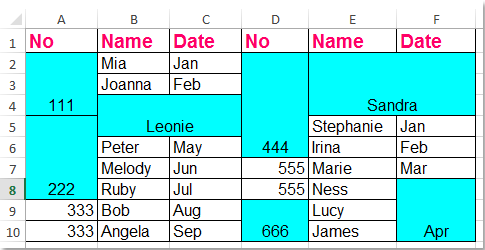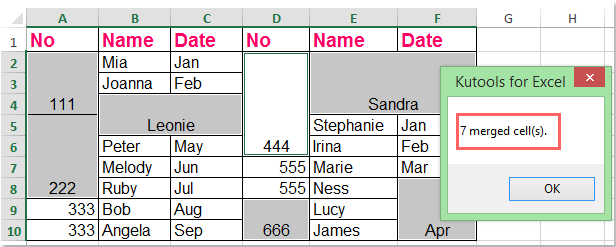Ինչպե՞ս բացահայտել և ընտրել Excel- ում միավորված բոլոր բջիջները:
Գիտե՞ք, թե ինչպես գտնել և ընտրել բոլոր միաձուլված բջիջները Excel-ում: Ահա երեք հետաքրքիր եղանակներ Excel-ում ընտրության կամ միջակայքի բոլոր միաձուլված բջիջները արագ բացահայտելու և ընտրելու համար:
Բացահայտեք և ընտրեք բոլոր միավորված բջիջները Find հրահանգով
Արագ ընտրեք և հաշվեք բոլոր միաձուլված բջիջները Kutools-ով Excel-ի համար
Բացահայտեք և ընտրեք բոլոր միավորված բջիջները Find հրահանգով
Ակտիվ աշխատաթերթում կարող եք նույնականացնել և ընտրել բոլոր միավորված բջիջները ՝ Գտնել հրամանը հետևյալ քայլերով.
1. Սեղմեք Գլխավոր > Գտեք և ընտրեք > Գտնել բացելու համար Գտնել եւ փոխարինել երկխոսության տուփ: Կարող եք նաև բացել այն Գտնել եւ փոխարինել երկխոսության տուփը սեղմելով Ctrl + F ստեղները:
2. Սեղմեք Ֆորմատ կոճակը երկխոսության դաշտում, (Եթե չկարողանաք պարզել Ֆորմատ կոճակը, սեղմեք Ընտրանքներ երկխոսությունը ընդլայնելու կոճակ:) տե՛ս սքրինշոթը.

3, Պատուհանման մեջ Գտեք ձևաչափը երկխոսության տուփ, միայն ստուգեք Միաձուլել բջիջները տարբերակը Տեքստի կառավարում բաժինը տակ Հավասարեցում էջանիշը և կտտացրեք OK.

4, Այժմ դուք վերադառնում եք դեպի Գտնել եւ փոխարինել երկխոսության վանդակում, սեղմեք Գտեք բոլորը կոճակ Բոլոր միավորված բջիջները նշված են այս երկխոսության տուփի ներքևում: Ընտրեք բոլոր գտնելու արդյունքները `պահելով Հերթափոխություն բանալի.
Այժմ ակտիվ թերթիկի բոլոր միավորված բջիջները ընտրվում են, երբ ընտրում եք գտնելու բոլոր արդյունքները: Տեսեք,

Հուշում. Եթե ընտրության մեջ ուզում եք միայն նույնացնել, գտնել և ընտրել միավորված բջիջները, նախ պետք է ընտրեք տիրույթը:
Ընտրեք և հաշվեք բոլոր միավորված բջիջները Kutools- ի համար Excel- ի համար
Excel- ի համար նախատեսված գործիքներ's Ընտրեք միավորված բջիջները գործիքը կօգնի ձեզ ինքնությունը, միայն մեկ կտտոցով գտնել և ընտրել բոլոր միավորված բջիջները ընտրության մեջ:
| Excel- ի համար նախատեսված գործիքներ : ավելի քան 300 հարմար Excel հավելվածներով, 30 օրվա ընթացքում առանց սահմանափակումների փորձեք անվճար. |
Տեղադրելուց հետո Excel- ի համար նախատեսված գործիքներխնդրում եմ արեք հետևյալ կերպ .( Անվճար ներբեռնեք Kutools Excel- ի համար հիմա: )
1, Ընտրեք տվյալների տիրույթը, որը ցանկանում եք ընտրել միավորված բջիջները:
2: Սեղմեք Կուտոլս > ընտրել > Ընտրեք միավորված բջիջները, տես նկարի նկարը.

3, Եվ ընտրության բոլոր միավորված բջիջները միանգամից ընտրվել են, և միաձուլված բջիջների քանակը նույնպես հաշվարկվում է, տես նկարի նկարը.
Բացահայտեք բոլոր միավորված բջիջները VBA կոդով
VBA 1. Որոշեք և առանձնացրեք բոլոր միավորված բջիջները
1, Պահեք պահեք ALT + F11 ստեղները, և այն բացում է Microsoft Visual Basic հավելվածների համար պատուհան.
2: Սեղմեք Տեղադրել > Մոդուլներ, և տեղադրեք հետևյալ մակրոը ՝ Մոդուլներ Պատուհանը:
Sub FindMergedcells()
'updateby Extendoffice
Dim x As Range
For Each x In ActiveSheet.UsedRange
If x.MergeCells Then
x.Interior.ColorIndex = 8
End If
Next
End Sub
3. Սեղմեք F5 այս մակրո գործարկման բանալին: Ակտիվ աշխատանքային թերթի բոլոր միավորված բջիջները նույնականացվում և ընդգծվում են, տես նկարի նկարը.

VBA 2. Որոշեք և թվարկեք բոլոր միավորված բջիջները
1, Պահեք պահեք ALT + F11 ստեղները, և այն բացում է Microsoft Visual Basic հավելվածների համար պատուհան.
2: Սեղմեք Տեղադրել > Մոդուլներ, և տեղադրեք հետևյալ մակրոը ՝ Մոդուլներ Պատուհանը:
Sub ListMergedcells()
'updateby Extendoffice
Dim x As Range
Dim sMsg As String
sMsg = ""
For Each x In ActiveSheet.UsedRange
If x.MergeCells Then
If sMsg = "" Then
sMsg = "Merged cells:" & vbCr
End If
sMsg = sMsg & Replace(x.Address, "$", "") & vbCr
End If
Next
If sMsg = "" Then
sMsg = "No merged cells."
End If
MsgBox sMsg
End Sub
3. Սեղմեք F5 Այս մակրո գործարկման ստեղնը, բոլոր միավորված բջիջները թվարկված են ելնող երկխոսության վանդակում: Տեսեք,

Առնչվող հոդվածներ
Ինչպե՞ս թույլատրել միացնել բջիջները Excel- ում պաշտպանված աշխատաթերթում:
Լռելյայնորեն, պաշտպանված աշխատանքային թերթը թույլ չի տալիս օգտվողներին միավորել բջիջները: Այնուամենայնիվ, դուք կարող եք բջիջները միաձուլել պաշտպանված աշխատաթերթի մեջ VBA մեթոդով, ինչպես մենք տրամադրում ենք այս հոդվածում:
Ինչպե՞ս միավորել բջիջները Excel- ում որպես աղյուսակ ձևաչափված տիրույթում:
Excel- ում դուք կարող եք հեշտությամբ միաձուլել իրար հաջորդող բջիջները մեկում Merge & Center օգտակար ծառայության հետ, ինչպես ցույց է տրված ստորև նկարված նկարում: Այնուամենայնիվ, այն չի կարող միավորել բջիջները մի տիրույթում, որը ձևաչափվել է որպես սեղան Excel- ում, կա՞ որևէ հնարք այն կարգավորելու համար:
Ինչպե՞ս միաձուլել բջիջները ՝ առանց բովանդակությունը կենտրոնացնելու Excel- ում:
Excel- ում Excel- ում երկու կամ ավելի բջիջներ միացնելիս Merge & Center գործառույթը կարող է օգնել ձեզ: Բայց երբեմն ինչպե՞ս կարող ես անել, եթե պարզապես ուզում ես բջիջները միաձուլել, բայց բովանդակությունը չկենտրոնացնել, ինչպես ցույց է տրված նկարում: Այստեղ, այս ձեռնարկի մեջ, ես ներկայացնում եմ Excel- ում այս աշխատանքը լուծելու մեթոդները:
Ինչպե՞ս խցկել բջիջները և լրացնել կրկնօրինակ արժեքներով Excel- ում:
Եթե ունեք մի աշխատաթերթ, որը պարունակում է բազմաթիվ միաձուլված բջիջներ, և այժմ դուք պետք է հանեք դրանք և ավտոմատ կերպով լրացնեք միավորված բջիջներից բնօրինակ արժեքները, ինչպես ցույց են տրված հետևյալ նկարները: Ինչպե՞ս կարող էիք արագ զբաղվել այս խնդրով:
Գրասենյակի արտադրողականության լավագույն գործիքները
Լրացրեք ձեր Excel-ի հմտությունները Kutools-ի հետ Excel-ի համար և փորձեք արդյունավետությունը, ինչպես երբեք: Kutools-ը Excel-ի համար առաջարկում է ավելի քան 300 առաջադեմ առանձնահատկություններ՝ արտադրողականությունը բարձրացնելու և ժամանակ խնայելու համար: Սեղմեք այստեղ՝ Ձեզ ամենաշատ անհրաժեշտ հատկանիշը ստանալու համար...

Office Tab- ը Tabbed ինտերֆեյսը բերում է Office, և ձեր աշխատանքը շատ ավելի դյուրին դարձրեք
- Միացնել ներդիրներով խմբագրումը և ընթերցումը Word, Excel, PowerPoint- ով, Հրատարակիչ, Access, Visio և Project:
- Բացեք և ստեղծեք բազմաթիվ փաստաթղթեր նույն պատուհանի նոր ներդիրներում, այլ ոչ թե նոր պատուհաններում:
- Բարձրացնում է ձեր արտադրողականությունը 50%-ով և նվազեցնում մկնիկի հարյուրավոր սեղմումները ձեզ համար ամեն օր:

